Flag of Cuba
The national flag of Cuba (Spanish: Bandera de Cuba) consists of five alternating stripes (three blue and two white) and a red equilateral triangle at the hoist, within which is a white five-pointed star. It was designed in 1849 and officially adopted May 20, 1902.[1][2]
 | |
| Use | National flag and ensign |
|---|---|
| Proportion | 1:2 |
| Adopted | May 20, 1902 |
| Design | Five horizontal stripes of blue alternate with white with the red equilateral triangle based on the hoist-side bearing the white five-pointed star in the center. |
| Designed by | Miguel Teurbe Tolón and Narciso López |
It is one of the two flags of a currently socialist country (the other being Laos)[3] that does not use any communist symbolism.
Past
Fighting for the Spanish Crown against the rebel armies of Venezuela, Narciso López moved from his native Caracas to Havana, Cuba. His involvement in anti-colonial movements forced him into exile. In 1849 he moved to New York City, where he continued to advocate for an independent Cuba.
The three blue stripes represent the three departments in which Cuba was divided at that time, the white purity of ideals, the light; the red triangle, originating from the French Revolution – and the three ideals of liberty, equality and fraternity: red for the blood and the courage; the star was the new state that should be added to the United States.
The poet Miguel Teurbe Tolón designed the flag alongside López, based upon the story of López's vision. Emilia Teurbe Tolón, Miguel's wife, sewed the first flag. López and Tolón, together with José Aniceto Iznaga Borrell,[4] his nephew José María Sánchez Iznaga,[5] Cirilo Villaverde and Juan Manuel Macias, settled upon the final design for the flag of Cuba: two white stripes, three blue, a red triangle, a lone star.
Narciso López used this same flag in 1850 to carry out his coup attempt to liberate Cuba from Spanish rule, which resulted in failure. The coastal town of Cardenas was the first town that saw the lone star flag hoisted on May 19, 1850, in the taking of the city by Cuban rebels.
A year after the start of the Ten Years' War, the first Constituent Assembly of the Republic of Cuba met arms in Guáimaro, Camagüey Province. The debate focused between two flags of great symbolism, the Demajagua – which was very similar to the Chilean flag – created by Carlos Manuel de Céspedes to give start to the war of independence, and the Lone Star of Narciso López, the latter being chosen since Narciso López had taken the first step for the freedom of Cuba. The Demajagua flag was not scrapped, but instead, was put in the sessions of the House of Representatives and retained as part of the national treasure.
On the morning of May 20, 1902, the day Cuba officially became an independent republic, Generalissimo Máximo Gómez had the honor of hoisting the flag on the flagpole of the castles of the Tres Reyes del Morro, Havana; therefore sealing with this act the end of the Cuban revolution, the end of struggle for Cuban independence, and at the same time justifying the sacrifice that so many offered to make this dream become reality.
Both the flag and the coat of arms were designed by Miguel Teurbe Tolón. The design of both specifications were established by decree of the first President of Cuba, Tomás Estrada Palma, on April 21, 1906. The flag has remained unchanged since then even during and after the 1959 Cuban Revolution, which established the present-day communist state of the Republic of Cuba.
Subsequent use
In April 1869, Narciso López's flag was designated the national banner by the Congress of the Republic of Cuba. López's flag was the model for the flag of Puerto Rico adopted in 1892 by the Puerto Rican Revolutionary Committee, a pro-independence group that worked under the auspices of the Cuban Revolutionary Party.
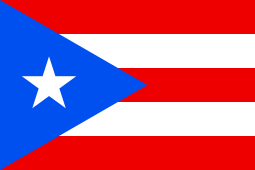

After the United States seized Cuba from Spain during the Spanish–American War, the U.S. flag flew from January 1, 1899, until independence was granted. On May 20, 1902, the Cuban national flag was hoisted as a symbol of independence and sovereignty. It has been used ever since, remaining unchanged after the Cuban Revolution of 1959. During the revolution, Cuban president Fidel Castro's 26th of July Movement created a party flag equally divided in red and black like the Angolan national flag usually in horizontal stripes and often with inscriptions, which is often flown on public buildings.
Controversy
On 2019 Cuba introduced the controversial "National Symbols Bill",[6] which according to official press releases "would establish more flexible use of these items with a view toward promoting their greater presence in society, within a legally defined, respectful framework". Among the tenets[7] that came with the bill was that the flag could be used "as a means of publicity only when the messages would contribute to the promotion and development of patriotic values in people and form a patriotic awareness of respect and veneration for them and the historical tradition of the nation".
On August 2019 independent artists launched the "#LaBanderaEsDeTodos" campaign[8] after repressive measures taken in response by the Cuban government,[9] including aforced disappearance of artist Luis Manuel Otero Alcántara.[10] The artists, members of the San Isidro Movement,[11] published a manifesto in which they advocated freer usage of Cuban national symbols, asking the public for assistance in opposing the Cuban government's attempts to restrict usage of the flag.
Specifications
.svg.png)
The Cuban flag is at a length-to-width ratio of 2:1. The blue and white alternating stripes are of equal width. The red chevron is in the shape of an equilateral triangle that does not extend to the middle of the flag. The star within the chevron has a radius that is 3⁄20 the length of the hoist. Its middle is halfway up the flag.
Other flags
 Flag of Cross of Burgundy (1521–1821).
Flag of Cross of Burgundy (1521–1821)..svg.png) Flag of Spanish America (1785–1898)
Flag of Spanish America (1785–1898)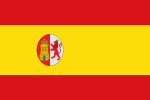 Flag of First Spanish Republic, Cuba, and Spain (1873–1874)
Flag of First Spanish Republic, Cuba, and Spain (1873–1874).svg.png) Flag of the First Republic of Cuba (1902–1906; 1909–1959)[12]
Flag of the First Republic of Cuba (1902–1906; 1909–1959)[12]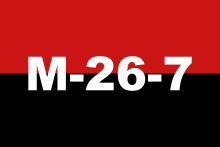 Party flag of the Movimiento 26 de Julio
Party flag of the Movimiento 26 de Julio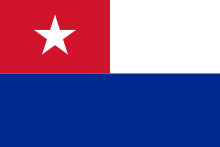 Naval Jack of Cuba, a.k.a. Flag of Yara or Flag of La Demajagua
Naval Jack of Cuba, a.k.a. Flag of Yara or Flag of La Demajagua Standard of the Prime Minister of Cuba (1959–1976)
Standard of the Prime Minister of Cuba (1959–1976)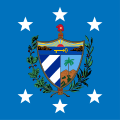 Standard of the President of Cuba
Standard of the President of Cuba
See also
- Coat of arms of Cuba
- Cuban trogon (Tocororo)
References
- "flag of Cuba". britannica.com.
- "History of Cuban flag and emblems". cubaflags.com.
- "Laos Flags and Symbols and National Anthem". www.worldatlas.com. Retrieved 2019-04-19.
- Jorge Iznaga. JOSE ANICETO IZNAGA BORRELL Iznaga Genealogy (IZNAGA - 1420 - Present), Retrieved 5 December 2012.
- Jorge Iznaga. JOSE MARIA SANCHEZ IZNAGA Iznaga Genealogy (IZNAGA - 1420 - Present), Retrieved 5 December 2012.
- http://en.granma.cu/cuba/2019-03-21/history-preserved-in-our-national-symbols
- [https://adncuba.com/noticias-de-cuba/actualidad/nueva-ley-de-simbolos-nacionales-incluye-prohibiciones-de-uso-en-sayas
- https://adncuba.com/actualidad/artistas-independientes-lanzan-reto-labanderaesdetodos
- https://www.latintimes.com/why-placing-cuban-flag-your-shoulders-could-take-you-jail-442785
- [https://hyperallergic.com/518206/cubas-campaign-against-artist-luis-manuel-otero-alcantara/
- https://twitter.com/Mov_sanisidro
- https://thumbs.worthpoint.com/zoom/images1/1/0216/05/cuban-flag-vintage-1940-pre_1_af5fe2b808af826e82e1e3de3c40ba4a.jpg
External links
| Wikimedia Commons has media related to Flags of Cuba. |
- Cuba at Flags of the World
- Cuba Flags—A historical insight into the flag and emblems of Cuba
- The Flag of Cuba on flagscorner.com